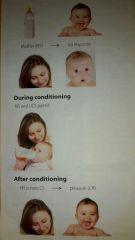![]()
![]()
![]()
Use LEFT and RIGHT arrow keys to navigate between flashcards;
Use UP and DOWN arrow keys to flip the card;
H to show hint;
A reads text to speech;
5 Cards in this Set
- Front
- Back
- 3rd side (hint)
|
What is the Learning Theory |
All behaviours are learned rather than inborn. We all are born with 'blank slates'. Types are classical and operant and the social learning theory |
|
|
|
Explain Classical Conditioning |

Pavlov had dogs, rang a bell when there was food and eventually the bell became associated with food so they'd salivate when the bell rang |
|
|
|
Explain operant conditioning |
First investigated by Skinner (made a box with rats in, if it presses the lever a food pellet falls into the cage, learns to press the lever for food). The person learns through reinforcement. |
Rats |
|
|
Explain Social Learning Theory |
Hay and Vespo ,suggested modelling could be used to explain attatchment, children observe parents affectionate behaviour and imitate this. Bandura is also a study in Social Learning theory. We learn through observing others and imitating behaviours which are rewarded |
|
|
|
Evaluation points on learning theories |
-Most research is based on animals -Learning theories suggest it's mostly food thay causes attatchment but Harlow says otherwise -we do learn from reinforcement and rewards influence us - does not explain how secondary reinforces work (I.e money - do not reduce discomfort but are still motivating and reinforcing) - Learning Theory not so much respected since Bowlby's theory |
|

